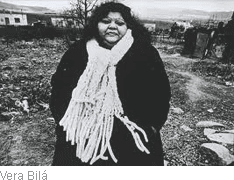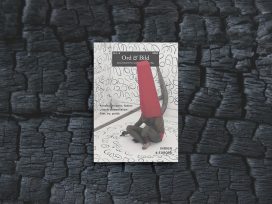Given the fact that there are multiple Romany cultures, any attempt to provide a comprehensive summary will prove futile. In the Czech Republic alone, there are approximately 3 to 5 main sub-ethnic groups of Roma, each displaying varying cultural and linguistic traditions. Moreover, any efforts by non-Roma to understand these cultures should be viewed with scepticism – an ethnic Czech will always remain an outsider. What follows are the thoughts and remarks of a sympathetic individual on the topic of urban Romany culture, rather than an academic study. If questions arise, the reader should consider consulting Roma directly.
The Roma
For some, there are far too many Roma. They want them to go back to wherever they came from, presumably India or somewhere far away. These advocates of “repatriation” call themselves sensible people and patriots. There are others who practice a less extreme but more insidious form of prejudice, backing away from definitions of Czech identity based on colour or race to focus on behaviour – these people insist they’re not racists. In addition, there are those who maintain that there’s no such thing as “the Roma”. Stressing the importance of social rather than ethnic ties for Roma identity, many scholars have sadly allowed their seemingly innocent theoretical stances to be exploited by politicians with aggressive populist agendas.
All that having been said, it’s fascinating to watch how the Romany minority has managed to thrive despite all to the efforts to annihilate it, symbolically and literally. The approximately 300 000 Roma in the Czech Republic have been labelled human vermin and nonentities by some, but none of these insults will make them disappear – they are here to stay.
Their country of origin is not Punjab or Rajasthan, but mostly Slovakia or the Czech Republic. During the hockey or football world championships, they naturally support the Czech team and happily bounce up and down with the rest of the fans: “He who doesn’t jump is not a Czech!” Although the highlights of traditional Romany cuisine are bobalki (sweet dumplings with a poppy-seed and honey topping), marikla (unleavened bread) and goja (roasted pig guts filled with seasoned potatoes), you would probably search in vain for them on the day-to-day Romany dinner table. In fact, you’re more likely to see the Roma serve a traditional Czech meal, such as pork roast or sirloin with sauerkraut and dumplings.
What I’m about to say may come as news to many Czechs: our Roma are Czech! Their identities are additive not divisive, which is to say they bring with them the wealth of both Czech and Romany identities. They’re the frontrunners in a Europe that is struggling to become multicultural. Magdaléna Karvayová, a Romany student at the Anglo-American University, speaking about how younger Roma regarded a recent census, captured precisely this sentiment: “I believe a lot of Roma are still ashamed of their identity. Personally, I am going to use my right to fill in two identities, Czech and Romany. After all, I am a Czech Romany.”
Despite not being accepted as such in broader Czech society (or even in the media), the majority of Roma view themselves as Czech. What Magdaléna typifies is a new assertiveness about identity that is common to young Roma, an assertiveness that is unlikely to be cowered by disrespect or intolerance. At best, we are witnessing the cultural conjunction of Romany wisdom and modesty, nourished by an oral tradition and likeable recklessness, with the openness and progressive force of Europe. This is not to deny the existence or ramifications of social deprivation, but contemporary Czech Romany culture exceeds the context of poverty, having a richness and variety that stems from a different set of cultural roots and history.
Being a Rom as an art form
The oral character of Czech Romany society has been a decisive factor in its development. Until the late 1960s, the Roma did not write in their mother tongue. Then, as now, Romany served as the language of every day communication in the home, while literacy was acquired in a second language at school. In the midst of a culture heavily dependent on writing, especially reading and institutional education, Romany culture co-existed by drawing on memory, tradition and learning by example.
Print cultures are in part defined by the fact that writing is a solitary activity, which requires a certain level of distance and abstraction in thought. Moreover, the written word places emphasis on uniqueness and originality in expression. In the simplest terms possible, oral Romany is everything that written culture is not: it requires sharing, human interaction, repetition, fixed phrases, flexibility, and context.
The Czech Republic is home to several Romany cultures – Slovak Romany culture, Vlah Romany culture and Hungarian Romany culture – but there is also a division between official and subterranean Romany culture. The former is standardized, performed in public, may have clear commercial goals and takes easily nameable forms (music, art, craftsmanship, literature, etc.). The latter is private, domestic, not for the eyes of gadje (the non-Roma), and not for profit – the culture of being a Rom or romanipen. Examples of both can be easily found, but let us agree that, where the Roma are concerned, things are not often what they seem. And while dressing up as Hungarian peasants and playing Gypsy music for tourists in an expensive café in the centre of Prague is a way to make a living, a cultured Rom will look for his customs elsewhere.
Play that funky music
Unquestionably, the most obvious and stereotypical display of living Romany culture is music. But even where Gypsy music is concerned, there are successful bands with large popular followings. (By the way, the use of “Gypsy music” is not arbitrary. As opposed to “Romany music”, the term “Gypsy music” works as a kind of trademark, as any professional Romany musician will confirm. To change the name of a well-established enterprise could be bad for business.) Moreover, there are numerous lesser-known groups that offer exciting fusions of the traditional and contemporary. Different bands are born and dissolved every day, and the turnover can be overwhelming, not least for the musicians themselves.
 A case in point, the fairy-tale-gone-wrong of the Rokycany-based singer Vera Bilá and her band Kale. Capitalizing on growing interest in ethnic music, the group became exceptionally popular in the 1990s and toured various European festivals. In her albums, Bilá popularized the style of music known as rom-pop: traditional Romany melodies and lyrics performed on electric instruments. During this period, she collaborated with celebrated non-Roma musicians, including the talented singer-songwriter Zuzana Navarová and the Slovak composer and producer Ján Kuric. All of which resulted in an interesting mix of the traditional and modern and undoubtedly made a lot of money. Despite her enormous talent and lack of pretension, the whole project eventually flopped, primarily due to health problems and a gambling addiction. Bilá recently returned from Slovakia, where she unsuccessfully attempted to restart her career with a new band. At present, she is facing eviction from her Rokycany flat.
A case in point, the fairy-tale-gone-wrong of the Rokycany-based singer Vera Bilá and her band Kale. Capitalizing on growing interest in ethnic music, the group became exceptionally popular in the 1990s and toured various European festivals. In her albums, Bilá popularized the style of music known as rom-pop: traditional Romany melodies and lyrics performed on electric instruments. During this period, she collaborated with celebrated non-Roma musicians, including the talented singer-songwriter Zuzana Navarová and the Slovak composer and producer Ján Kuric. All of which resulted in an interesting mix of the traditional and modern and undoubtedly made a lot of money. Despite her enormous talent and lack of pretension, the whole project eventually flopped, primarily due to health problems and a gambling addiction. Bilá recently returned from Slovakia, where she unsuccessfully attempted to restart her career with a new band. At present, she is facing eviction from her Rokycany flat.
The Prague-based Bengas are experiencing similar international success with their highly energetic Spanish-style music, heavily dependent on the riffs of three semi-acoustic guitars. This younger generation of urban Roma seems to be better equipped for unexpected fame and fortune, which they’ve enjoyed for the past ten years.
Generally touring on the summer festival circuit, a number of popular bands come from smaller towns such as Liberec (Dusan Kotlár cimbalom band), Svitavy (Tockolotoc) or Hradec Králové (Terne Chave). Their music ranges from very traditional Gypsy music to Gypsy jazz, with stops in Slovak and Moravian folklore, Spanish flamenco and even funk (Brno-based Gulocar).
Alongside these more popular projects, we can’t forget the solo careers of singer-songwriters such as the late Jan Aco Slepcik, whose deeply personal lyrics and intimate renditions followed in the footsteps of the finest folk singers. By contrast, the composer and violinist Vojta Lavicka has tried his hand at wedding bands, large commercial projects and film scores, only to recently land with a major Roma hip-hop group Gipsy.cz. At the same time, he has maintained a political career as an advisor to various governmental and non-governmental bodies dealing with Roma issues.
In recent years, Romany communities across Europe, the Czech Republic included, have been overtaken by a wave of interest in R&B and hip-hop. While music originating in the African-American community might have enormous potential for exploring issues of civil rights, regional adaptations of this style have, thus far, regrettably not gone beyond mimicking the tough guys and sexy girls of MTV videos. However, Gipsy.cz has consciously taken up the cause of promoting Roma rights and integration, combining excellent music with significant messages.
It is impossible to mention all the different bands and individuals who operate as bridges between Romany and ethnic Czech culture. As a final remark on Gypsy music, we should not neglect the role of otherwise questionable reality shows such as “Superstar” and “Czecho-Slovakia’s Got talent”. Thanks to these programs, an average member of the Czech viewing public has repeatedly had the opportunity to see beyond the stereotypes of an antisocial underclass, sampling of the largely unexplored talent in singing, dancing and playing instruments that exists amongst the Romany minority.
Romany: The influence that makes a difference
If music is the most striking aspect of Romany culture, then literature is the most surprising. Romany writing in the Czech Republic only appeared in the late 1960s – making it possibly the youngest branch of European literature. It would not have happened without the influence of Milena Hübschmannová, a linguist and the founder of Roma studies, who encouraged her Romany friends to try writing in Romany, while she worked on the creation of a practical model of Romany orthography (still in use, with only minor changes). Only recently, Emil Cina, a Romany writer and ex-radio presenter, mentioned to me: “How I miss that woman! She was really something, both as a scholar and human being.”
Thanks to the existence of the Gypsy-Roma Union (1969-1973), the foundations were laid for what, forty years later, has become a spontaneously developing, self-directed field of literature. That having been said, it took the likes of Hübschmannová to give Roma the confidence to use the language of their homes for the higher purposes of literature.
As might be expected, there’s great controversy involved in writing Romany. The numbers of Romany-speaking members of the Czech majority are growing, mostly thanks to the existence of the Roma Studies department at Charles University. And it’s also true that a community of Roma writers, who can appreciate each other’s turn of phrase in Romany, has been firmly established, even if it remains small and on the margins of the mainstream. All the same, it’s presently impossible to publish solely in Romany, as there’s no market for it. Given its limited audience, some believe that Romany writing has no future, particularly because those who could read it naturally are not in the habit of reading in Romany. Only time will tell.
Without being the source language of prose and poetry written by Roma, Romany would not have the unique sound and feel that it now has. Contemporary Czech readers find it fascinating precisely because it is nourished by an inherited story-telling tradition inherited – even if they receive it in a watered-down, bilingual version that is now the standard publishing strategy.
A possible reason for believing in Romany writing is the fact that new authors are emerging without direct interference from Roma studies enthusiasts. The likes of Irena Eliásová or Roman Erös began writing out of a sheer need to share their experience with wider audience. The chances are that they would have never dared to write had there been no Tera Fabiánová or Andrej Gina.
Fabiánová, Gina, Lacková and Dzurko are only some of the pioneers who risked putting their pens to paper to save the legacy of traditional Romany storytelling for the future. They primarily looked back over their shoulders to the times when their parents were young or they were children. But there are others facing up to the challenges of the present by telling stories – unemployment, gambling, debt, drug abuse, prostitution, incarceration, emigration and so on. Romany is a literature under construction, but that is precisely its greatest attraction.
We know better
Earlier, I mentioned that Roma in their twenties are perhaps different from their predecessors. Something unprecedented is happening – they are educated, confident, they speak foreign languages and they are not afraid to be who they are. They are ready to demand their rightful places in society.
Last summer, I had a unique opportunity to meet some members of this generation at a workshop called Colorful but Colorblind: The Creative Use of Multimedia in Promoting Social Integration of Roma (Transitions Online was the organizer). The objective of the project was to teach both Romany and non-Romany journalists how to make use of online video footage to tell Roma-related stories.
It was an excellent occasion to learn filmmaking skills from people who had a lot of experience in the field. It was also an opportunity to learn that young people like Mária Husová, David Tiser, Frantisek Bikár, Petra Zajdová and Jan Berousek were not going to compromise their views on their own community. The mostly American crew consisted of senior filmmakers and graduates of the School of Communication at the University of Miami. They were aiming to fulfil all the aesthetic and functional requirements for a well-made online video. The Romany participants of the workshop, however, thought that the teachers’ priorities made it impossible to tell the stories truthfully and in accordance with their own objectives. The ensuing clashes were perhaps a hindrance to the project as such, but they showed how aware Romany participants were of their background, how clear their ideas about its presentation were, and how unwilling they were to allow any kind of colonization of the mind.
One of the first stories the Czech-Roma teams told me was about the artist Ladislava Gaziová. She comes from a mixed Roma-Slovak background but rediscovered her sense of ethnic belonging while studying at the Academy of Arts in Prague. Gaziová prefers not to be called a Roma artist because she finds it limiting. Nevertheless, a lot of her motifs come from the Romany community. She’s an up-and-coming artist whose spray-painted works are inspired by graffiti as much as the recollections of Romany gatherings from her father’s side of the family.
These young Roma show no hesitation in speaking up for their community. They want to be heard and they will not compromise. Unlike their parents, they do not respect the restraints because of their origins.
Goja and time
Several of Andrej Gina’s short stories take place in the back of his lorry, where he sells goja (pig guts) and pasvare (ribs), the bases for popular Romany dishes. Gina drives his lorry around the Czech Republic, stopping mostly in Roma neighbourhoods, and while he peddles his goods, he chats with people. And because he is a thinker, it’s not just small talk but matters of consequence: Why are Roma forgetting their language? Why use Czech numbers when there are perfectly good numbers in Romany? Why is it so hard for Roma to get jobs? How come so many people gamble?
He invokes images such as himself leaning against the side of his lorry, arms crossed on his chest. Several men are standing around, smoking and kicking stones, and the women have put down their shopping and are gesturing animatedly to press their point. Meanwhile, children and dogs are happily running about, chasing a burst football.
The streets in Romany neighbourhoods constantly witness such scenes. Romany live in the street, in contrast to their ethnic Czech counterparts, who treasure their privacy and rush home or to the pub after work to meet particular friends. Wherever you go – Maticni Street in Usti nad Labem, Chánov in Most, Lunik IX in Kosice – the public space in front of council houses is always full of groups of people chatting away. In Litvinov, Chomutov or Novy Bor you can tell a Romany neighbourhood by the fact that people take their coffee outside – they pull out an old rickety table, a couple of chairs or at least some crates to perch on, and enjoy their drinks together. It would not be fair to sneer: “Of course they’re having a break, they’re unemployed!” A) There is often no work to be had, and B) Roma always have time to chat because they genuinely enjoy the presence of other people.
Romany culture rests on living your life with fellow human beings and enjoying every little moment. For example, Romany university students in Prague regularly eat together – friends from several households gather in the evening to chat about their days and what’s new. Even in moments of gravity, Roma love joking. At an anti-Nazi rally recently, while the wonderfully mixed crowd of Romany and non-Romany supporters of racial tolerance were being threatened by a head-on clash with heavy-booted skinheads, a slightly tipsy local Rom behind me commented: “This is like being at a hockey game!”. And when the crowd started singing the Czech anthem in response to the immediate threat of violence, he added: “Didn’t I tell you? Now we get to sing the anthem, too!” In Romany life an informal social gathering can occasionally turn into a musical performance, which is welcomed with as much respect and formality as any classical music concert in a major music hall.
The word culture is misleading. The way you treat your elders is culture. How you approach your daily meals is culture. The ear you lend to someone who has something to say is a sign of culture, too. Music, literature and art aside, Czech Roma have a sophisticated and unique culture, which continues to bloom even in the middle of the most deprived ghettos. And it’s worth trying to get to know them better, because there is much to learn.

 A case in point, the fairy-tale-gone-wrong of the Rokycany-based singer Vera Bilá and her band Kale. Capitalizing on growing interest in ethnic music, the group became exceptionally popular in the 1990s and toured various European festivals. In her albums, Bilá popularized the style of music known as rom-pop: traditional Romany melodies and lyrics performed on electric instruments. During this period, she collaborated with celebrated non-Roma musicians, including the talented singer-songwriter Zuzana Navarová and the Slovak composer and producer Ján Kuric. All of which resulted in an interesting mix of the traditional and modern and undoubtedly made a lot of money. Despite her enormous talent and lack of pretension, the whole project eventually flopped, primarily due to health problems and a gambling addiction. Bilá recently returned from Slovakia, where she unsuccessfully attempted to restart her career with a new band. At present, she is facing eviction from her Rokycany flat.
A case in point, the fairy-tale-gone-wrong of the Rokycany-based singer Vera Bilá and her band Kale. Capitalizing on growing interest in ethnic music, the group became exceptionally popular in the 1990s and toured various European festivals. In her albums, Bilá popularized the style of music known as rom-pop: traditional Romany melodies and lyrics performed on electric instruments. During this period, she collaborated with celebrated non-Roma musicians, including the talented singer-songwriter Zuzana Navarová and the Slovak composer and producer Ján Kuric. All of which resulted in an interesting mix of the traditional and modern and undoubtedly made a lot of money. Despite her enormous talent and lack of pretension, the whole project eventually flopped, primarily due to health problems and a gambling addiction. Bilá recently returned from Slovakia, where she unsuccessfully attempted to restart her career with a new band. At present, she is facing eviction from her Rokycany flat.




